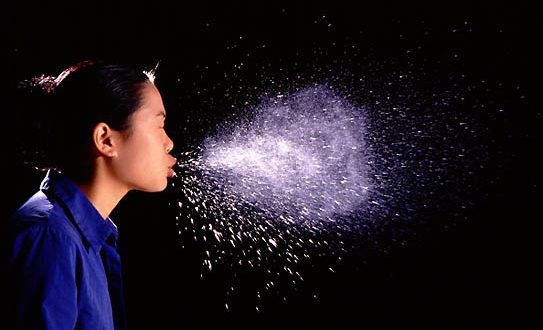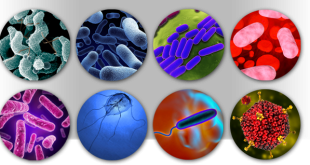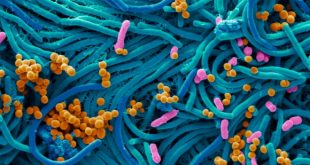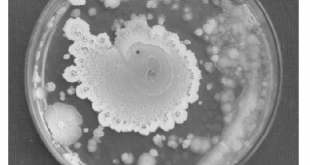Aeromicrobiology is the study of living microbes which are suspended in the air. These microbes are referred to as bioaerosols. Though there are significantly less atmospheric microorganisms than there are in oceans and in soil, there is still a large enough number that they can affect the atmosphere (like they can even contribute in cloud formation).
- Once suspended in the air column, these microbes have the opportunity to travel long distances with the help of wind and precipitation, increasing the occurrence of widespread disease by these microorganisms.
- These aerosols are ecologically significant because they can be associated with disease in humans, animals and plants. Typically microbes will be suspended in clouds, where they are able to perform processes that alter the chemical composition of the cloud, and may even induce precipitation.
- In dry weather the microbial load in air is higher than that of wet weather. The rain washes microorganisms of air.
Bioaerosol
- The bioaerosol are the atmospheric particles, mist of dust of µm range, associated with metabolically active or inactive viable particles.
- Bioaerosols vary considerably in size and composition depends on a variety of factors including the type of microorganism or toxin, the type of particles they are associated with such as mist or dust and gases in which the bioaerosol is suspended.
- Bioaerosol in general range from 0.02-100 µm in diameter and are classified on the basis of their size.
- The composition of bioaerosol can be liquid or solid or the mixture of the two and should be thought of as microorganisms associated with air borne particles. This is because it is rare to have microorganism (toxins) that are not associated with other airborne particles such as dust or mist.
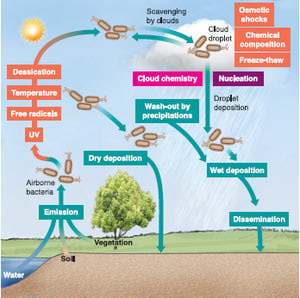
Major Characteristics and Stratification of the Atmosphere
Best safe and secure cloud storage with password protection
Get Envato Elements, Prime Video, Hotstar and Netflix For Free
Best Money Earning Website 100$ Day
#1 Top ranking article submission website
- For the most part, the chemical and physical parameters of the atmosphere do not favor microbial growth and survival.
- Temperature decrease with the increase of in height. At the top of the troposphere, temperatures are -43 to -83 degree Celsius, which is below the minimal growth temperature.
- The low concentrations of organic carbon are insufficient to support heterotrophic growth.
- Available water is also insufficient, limiting even the possibility of autotrophic growth.
- Microorganisms in the atmosphere are exposed to high intensities of radiation. Exposure to UV light causes lethal mutation.
Atmosphere is habitat and Medium for microbial dispersal
- Even though the atmosphere is a hostile environment for microorganisms, there are substantial numbers of microorganisms in the lower troposphere where, because of thermal gradients, there is rapid mixing of air.
- Temporary locations in the troposphere may provide habitats for microorganisms. Clouds possess concentrations of water that permit growth of microorganisms. Light intensities and carbon dioxide concentrations in cloud layers are sufficient to support growth of photoautotrophic microorganisms.
- In industrial areas, there may even be sufficient concentration of organic chemicals in the atmosphere to permit growth of some heterotrophs.
- Although many microorganisms that grow in the hydrosphere and lithosphere can become airborne, there are no known autocthonous atmospheric microorganisms.
- Some microorganisms become airborne as growing vegetative cells, but more commonly microorganisms in atmosphere occur as spores. To facilitate discussion, the term spore is used as an extended sense and includes cysts, soredia, and other non-vegetative resistant structures.
Several properties of spores contribute to their ability to withstand transport through the atmosphere. Such as:
- Low metabolic rates help spores overlong periods.
- Spores are produced in high numbers; some fungi, for example, produce in excess of 1012 spores per single fruiting body per year.
- Some spores are extremely thick walled, which protect them against severe desiccation.
- Some spores are pigmented, which add protection against exposure to damaging UV radiation.
- The relatively small size and low density of spores permit them to remain air-borne for long periods before they sediment from the atmosphere.
- Usually, spores are relatively light; they may even contain gas vacuoles.
- Spores are of variety of shapes; some are aerodynamically favorable for extended lateral travel through the atmosphere.
- Spores whose primary function is dispersal are known as Xenospores.
Microbial Communities
Many different microorganisms can be in aerosol form in the atmosphere, including viruses, bacteria, fungi, yeasts and protozoans. In order to survive in the atmosphere, it is important that these microbes adapt to some of the harsh climatic characteristics of the exterior world, including temperature, gasses and humidity. Many of the microbes that are capable of surviving harsh conditions can readily form endospores, which can withstand extreme conditions.
Bacterial: Bacillus, Staphylococcus, Micrococcus, Sarcina, Mycobacterium, etc. are found in the air.
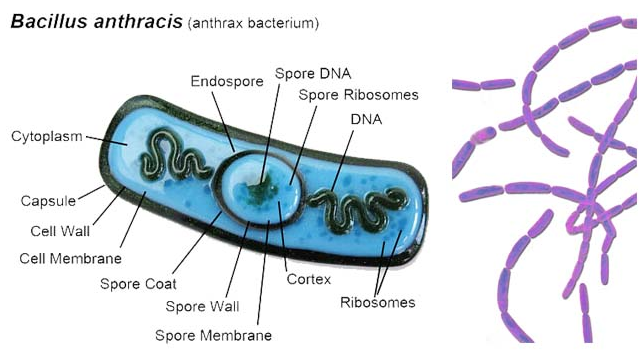
Bacteria that can resist environmental stresses is Bacillus anthracis. It is a gram positive, rod shaped bacteria that utilizes spore formation to resist environmental stresses. The spore is a dehydrated cell with extremely thick cell walls which can remain inactive for many years. This spore makes Bacillus anthracis a highly resilient bacteria, allowing it can survive extreme temperatures, chemical contamination, and low nutrient environments. This bacteria is associated with Anthrax, which is a severe respiratory disease that infects humans. Conidia of Streptomycetes are also available in air.
Fungal: The mycroflora of air consists of chiefly of spores of fungi, especially Penicillium, Aspergillus, Cladosporium, Hemodendrum, and ascospores of yeast.
Fungi that can resist environmental stresses is Aspergillus fumigatus, which is a major airborne fungal pathogen. This pathogen is capable of causing many human diseases when conidia are inhaled into the lungs. While A. fumigatus lacks virulence traits, it is very adaptable to changing environmental conditions and therefore is still capable of mass infection.
Viral: An example of a viral airborne pathogen is the Avian Influenza Virus, which is a single stranded RNA virus that can infect a broad range of animal species as well as humans and cause the Avian Influenza.
Revised by
- Md. Siddiq Hasan on 03 March,2021
Best safe and secure cloud storage with password protection
Get Envato Elements, Prime Video, Hotstar and Netflix For Free
 Plantlet The Blogging Platform of Department of Botany, University of Dhaka
Plantlet The Blogging Platform of Department of Botany, University of Dhaka
